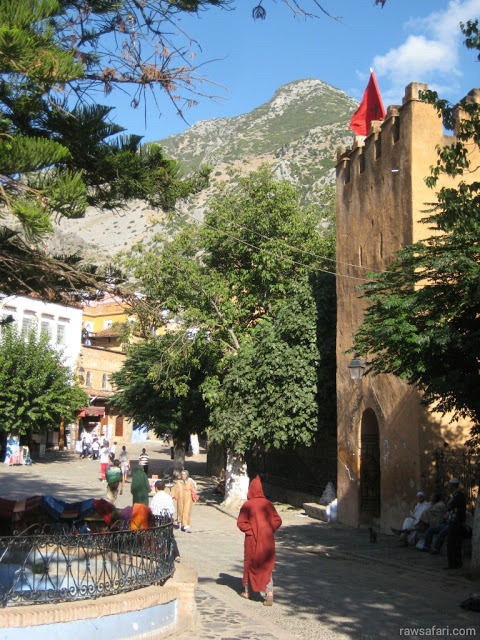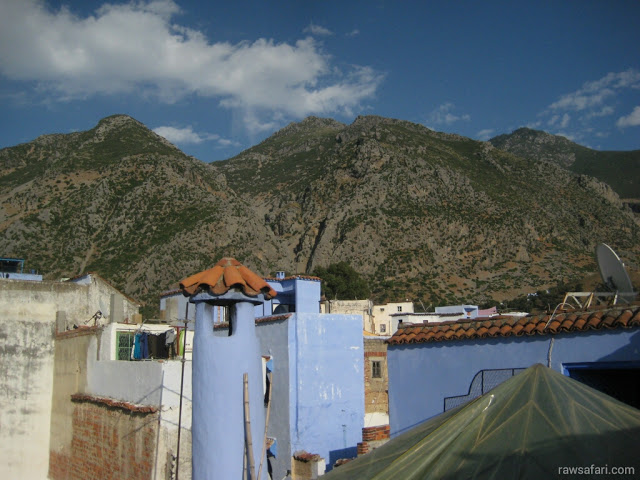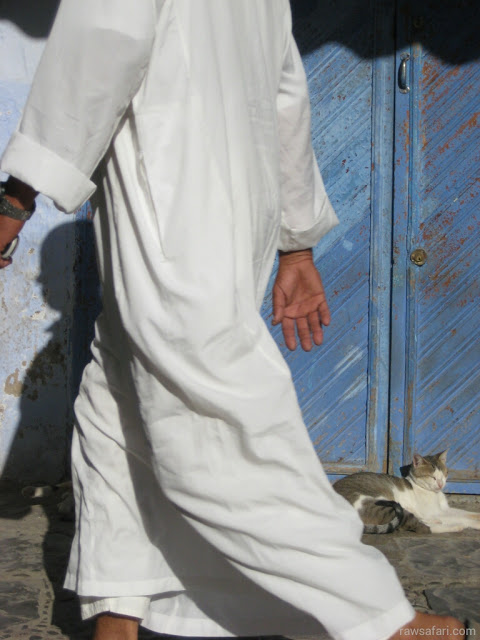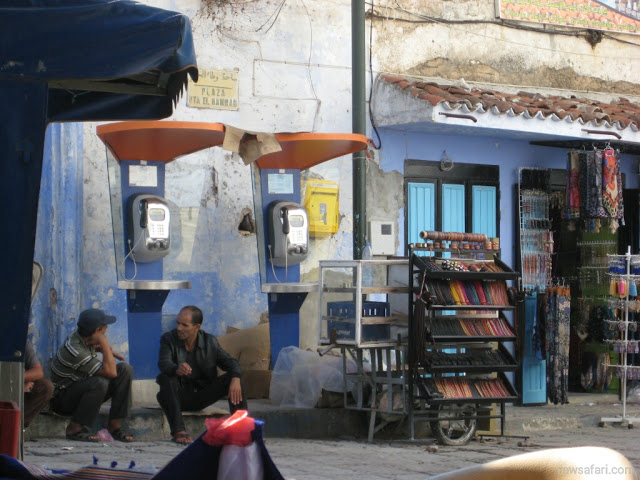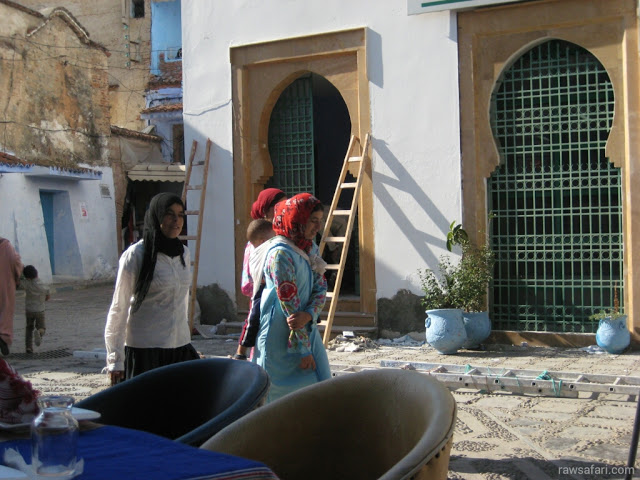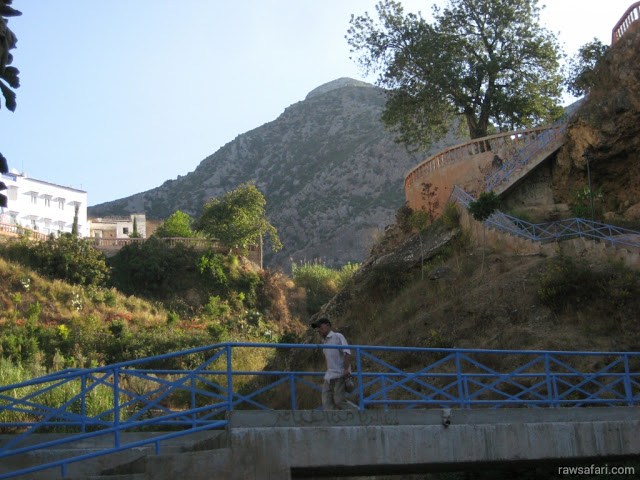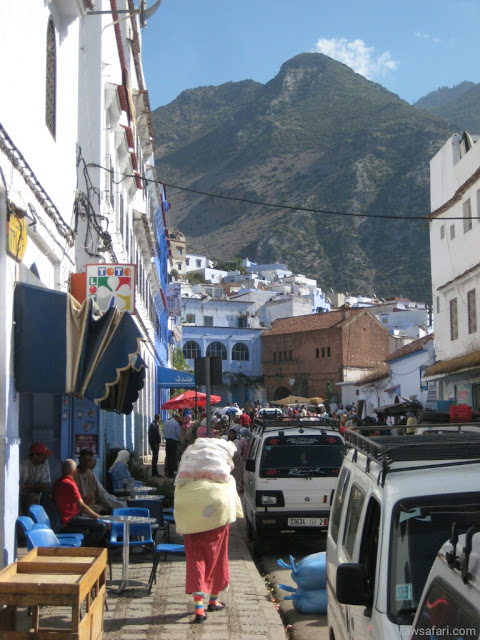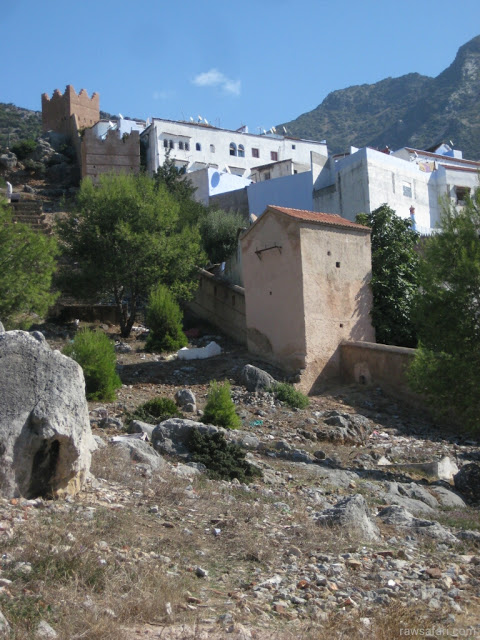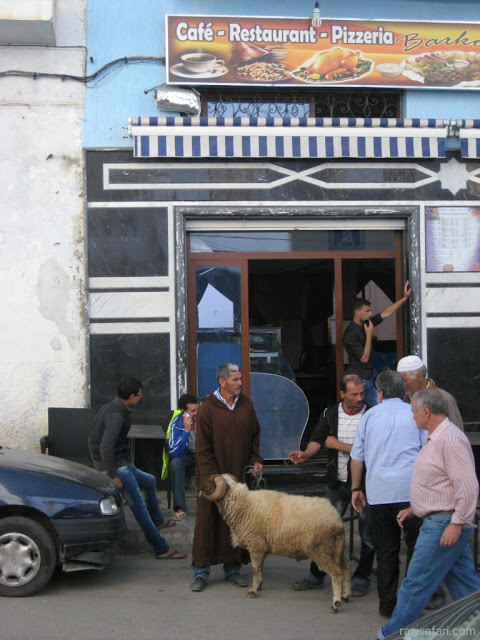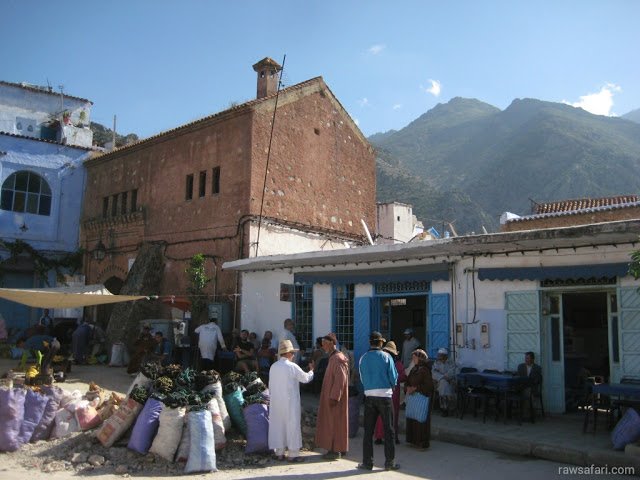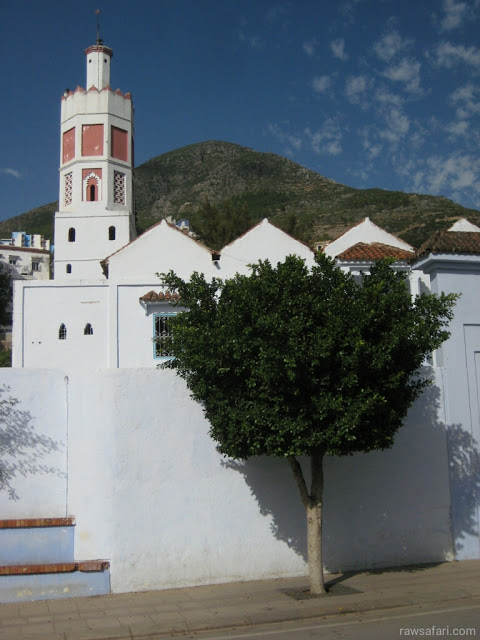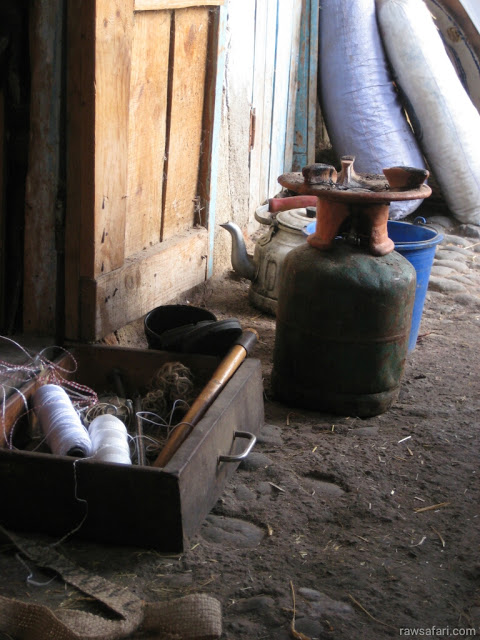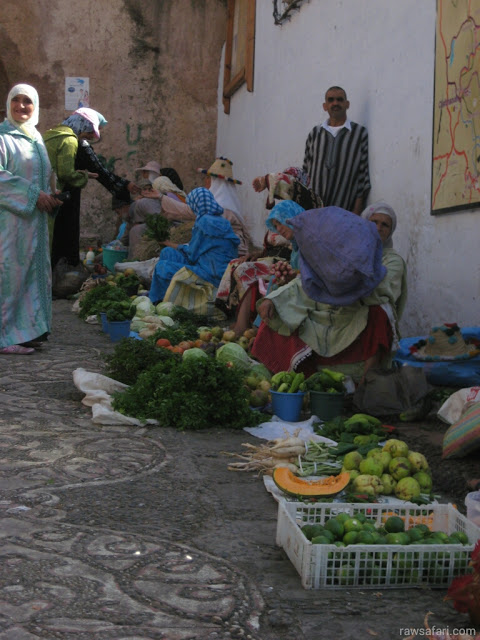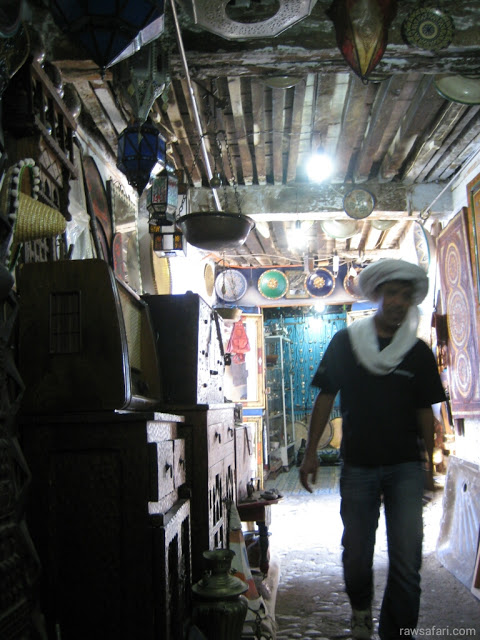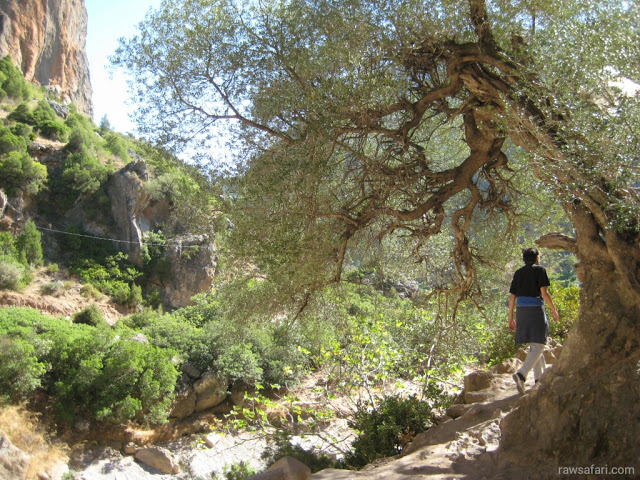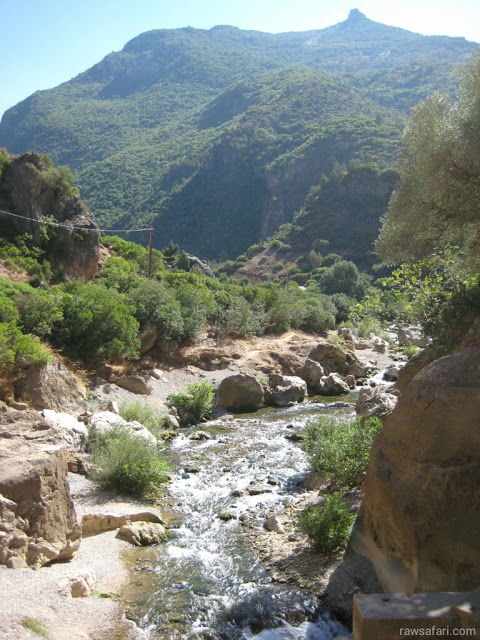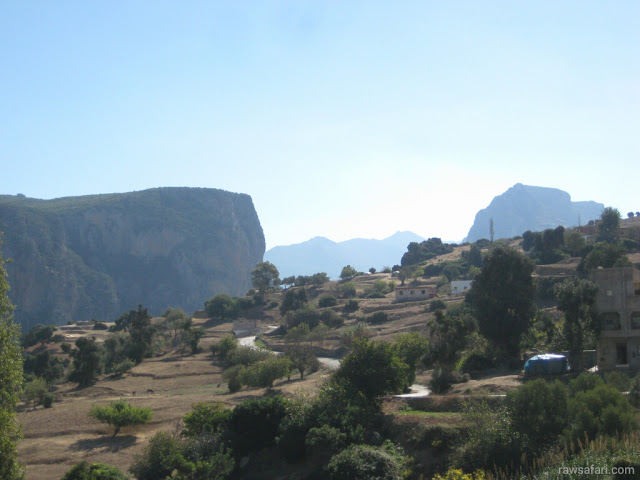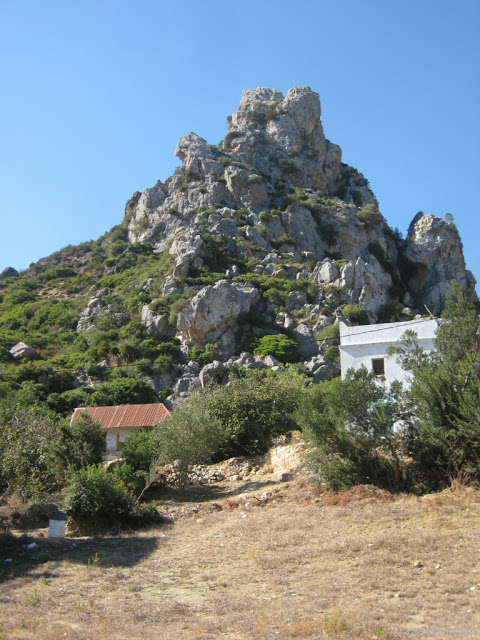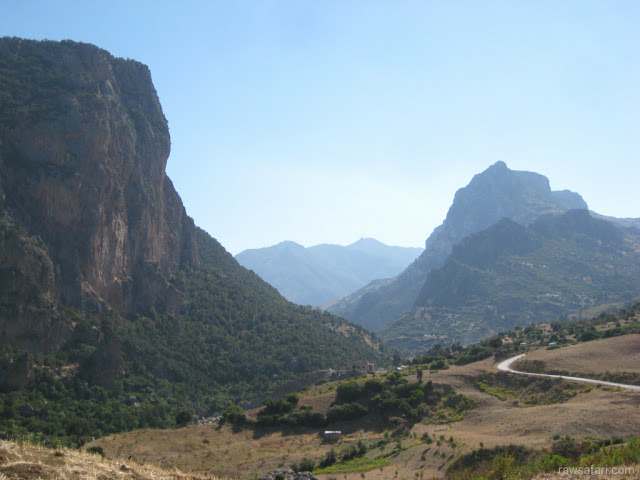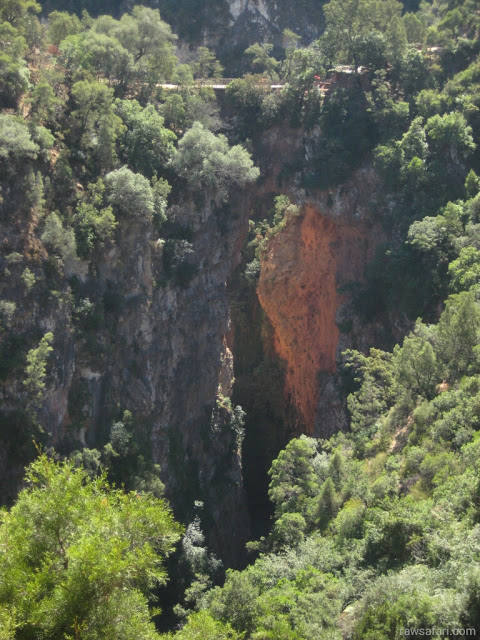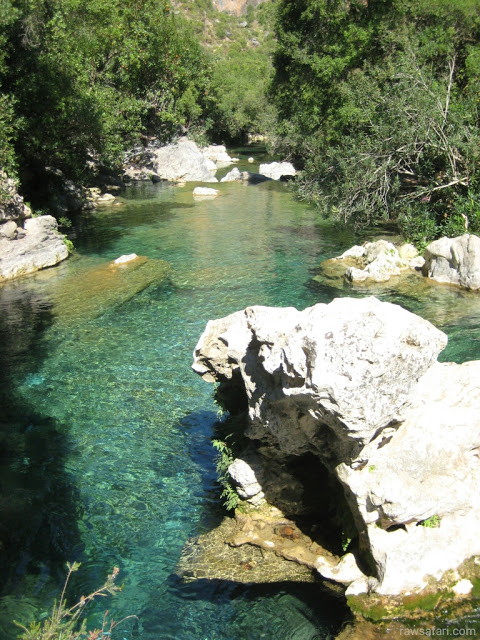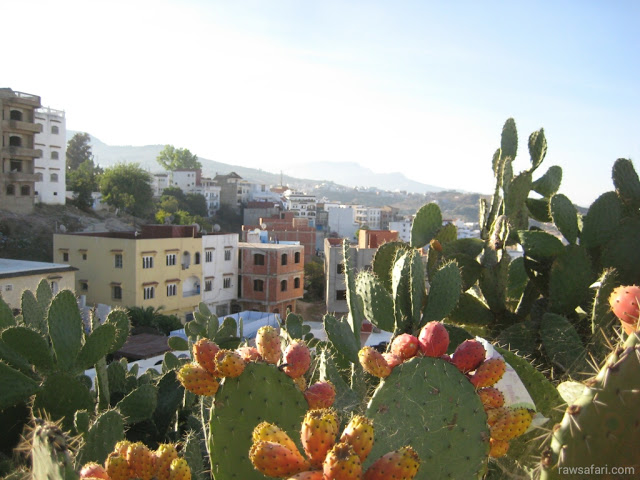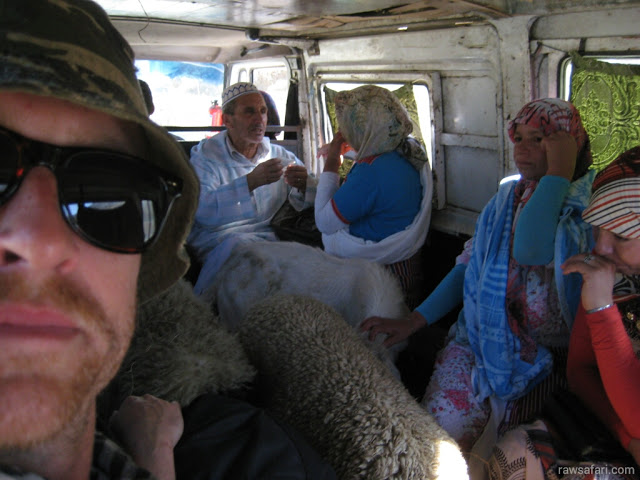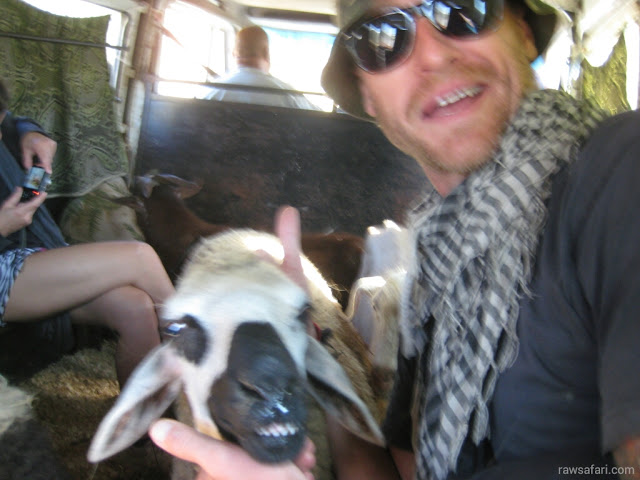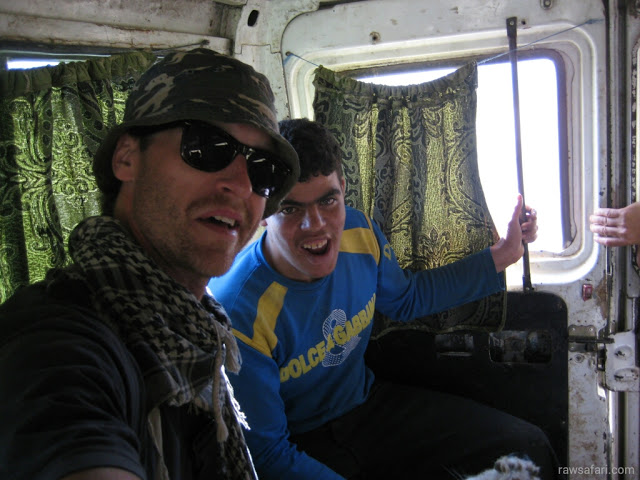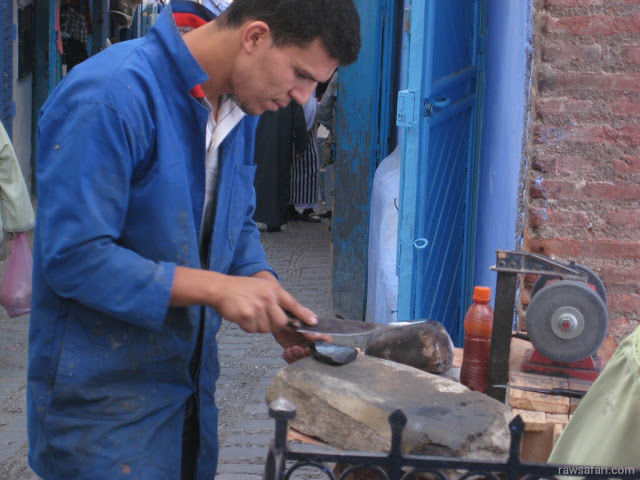…the town has become a bit of a pilgrimage for pot heads in the last ten years, because the hill country is full of huge marijuana crops…
I ride into Chefchaouen with a sporty gent in his elegant ’70s Merc’ coupe. The steady climb up the mountain roads makes me alternately sleepy and dizzy, but I am kept alert by my driver’s aggressive driving. He passes trucks, busses and herds of goats on the winding narrow road, with reckless abandon. It’s Eid Al Adha in a few days, so the goats and tourist busses are swarming into town in anticipation of the party. Every family in Morocco will buy a goat, and on the morning of the 16th, cut it’s throat ceremonially and BBQ it. If there’s one thing Aussies love it’s BBQ lamb. I can’t wait.
( Top pic: the main square of Chefchaouen’s medina. )
I do my usual survey of the local hotels and find the best deal available at the friendly “Hotel Andaluz”. The room is cosy and clean, and is right on the roof terrace with magnificent views. It has hot showers and free WiFi. Well worth US$12 a night. (Interesting sidebar: the Hotel Andaluz, I am told, was built in the 1470’s as a stately family home and only converted into a hotel in the 1970’s, when the building was 500 years old.)
Chefchaouen is known as the “blue city”. It is situated high in the Rif Mountains. The town is perched in an alpine valley, at the foot of two dramatically steep summits. The town has become a bit of a pilgrimage for pot heads in the last ten years, because the hill country is full of huge marijuana crops.
( The view from the hotel terrace. )
I take a stroll round town in the gathering twilight. Chefchaouen is undoubtedly the most attractive and charismatic Moroccan town I’ve been in so far. The famous blue and white colour scheme of the city medina, and its steep, narrow footpaths make me feel like I am in a story book. The night market traders are all opening their shutters, and the streets are cluttered with the simple vegetable stalls set up by the Rif Mountain tribespeople. As in Tangier, traditional costume is part of everyday life here. Local men routinely wear long hooded “jalaba” and women are veiled and elegant in velvet or satin dresses. The Rif women get around in brightly coloured robes, and unusual straw hats, decorated with pom-poms.
( Chefchaouen. )
I am told by locals, Chefchaouen was originally given it’s famous blue paint job by Jewish settlers who came to the city when they were driven out of Spain, along with the Moorish peoples, in the middle ages. The Jewish community is no longer present, but the city has always retained the color scheme.
I pick up fresh bread, olives, goat cheese and dried figs in the market, sit on the terrace, and stuff myself, watching the sun set over the mountains.
After dinner I am joined on the terrace by a pair of Macedonian backpackers, Bojan and Makedonka. We have a lot of things in common, including a passion for British comedy, travel, hitchhiking, and goat cheese. They are planning an excursion to the nearby National Park for the following day, to visit a famous waterfall. They invite me to go with them.
While the Macedonians and I are happily swapping Basil Fawlty quotes, there is a sudden raucos sound from the street below. Drumming, horns, chanting, yahooing. We scamper down stairs to see what it’s about. The music seems to be moving fast through the city, and we trot down the narrow pathways, looking for the source. Just when we think we are getting close, the music suddenly stops, like a cricket chirping at night. A young man we pass solves the mystery. “It is a wedding party. They will take the bride from house to house, playing music, until they reach the groom’s family home.” We thank our informant and head off again, determined to catch a glimpse of the procession. “Do not take pictures”, warns the young man as we set off.
Moroccan’s, espeially those in Chefchaouen, do not like to be photographed. I have already noticed this in other places, and have become even more surreptitious and sneaky than usual. Rounding a corner we finally discover the procession. Forty or so men, in high spirits, playing traditional horns and drums, and carrying a small curtained litter, which presumably contains the virgin bride. I try to take a few sneaky pictures, but without a flash, the galloping wedding party are nothing but a blur as they career around the next turn and out of sight.
At 5am the following morning I find out why my cosy rooftop room, with killer views, was so cheap. The Imam of the mosque next door launches into his slightly off key call to prayer, and the mosque loudspeakers sound like they are hanging outside the door of my room. Every house in town now has a sheep or two installed, in anticipation of the Eid Al Adha slaughter, and the racket of the prayer call sets them off, bleating with alarm. I restrain a powerful urge to go on the terrace in my boxer shorts and belt out a few choruses of “The Sound of Music”. Instead, I plug my ears, and drift back to sleep, giggling about Monty Python;
“…those bells are getting louder! …we don’t get Buddhists playing bagpipes in our bathroom! Or Hindus harmonizing in the hall! The Shintos don’t come round shattering sheet glass in the shithouse, and shouting slogans…”
Hunting my breakfast in the market, I discover that Chefchaouen has it’s own special brand of touts.
“Hey amigo, how are you my friend? You want to buy hashish? Best hashish! Want to see the best marijuana fields my friend? You have never seen so much hashish! Come, my friend, I will show you the hash factory. The best hashish! The best!”
I have figured out the best way to deal with these guys now. Out-weird them. I launch into a loud rendition of Tina Turner’s “Simply the Best”, complete with karaoke face contortions. The touts look puzzled.
“…Australian…” I hear one of them mutter.
There is a particularly photogenic bunch of Rif tribe ladies selling chickens and vegetables near the medina gate. I whip out my camera and hastily line up a shot, but the ladies camera awareness borders on supernatural and I can see they are onto me. Just as I get the frame, I cop a capsicum right between the eyes. Another first. I’ve photographed shy people, but I’ve never actually had vegetables thrown at me before. Point taken ladies. I retreat apologetically before they start throwing chickens. Ironically, the only people in Morocco who are not camera shy are the touts, so cultural harmony is probably an unatainable goal today.
After breakfast, I set out for the national park with the Macedonians. We get rides pretty easily. Our last ride is in a beat up old van with a bunch of locals and their Eid Adha goats. I get out my camera, and a young guy sitting by the tail gate offers to take a shot of me. I hand over my camera and he starts framing me up, struggling a bit to keep steady on the bumpy road. He leans back further and further, trying to get all of my absurdly large Australian limbs in the shot. The Van hits a pothole, and the photographer lurches violently off the bench, and through the open door of the van. He grapples awkwardly with the door handle, endeeringly concerned about hanging onto my camera, despite his position. Bojan the Macedonian and I grab hold of a sleeve each and we manage to get him back inside without injury. He’s our new best friend.
At the end of the ride, the van driver hits us hitchhikers up for a tenner each. We pay him resignedly and he rattles away.
Bojan says dryly: “well, that was smelliest, and most expensive ride of day. Also though, most entertaining”. Macedonians are funny people.
The national park turns out to be well worth the trip. The river is beautiful. Clean, green, and deep water invites me irresistably, and I dive in. It’s cold, but bearable, and the clarity is spectacular.
We never actually reach the waterfall. A few sketchy looking guys offer to show us around, but the waterfall sounds exhaustingly distant. We are content with the river, and wandering around aimlessly in the hills. At the top of one gorge we find “Pont de Dieu” a rock formation resembling a bridge, that spans the river. It is a very pretty place, and there is a small affable man in a mud hut with a gas ring, who sells us some strong cheap coffee, before we turn around and amble back to the river for another swim.
Back in town, the bleating and praying is now counterpointed by the scraping of countless hand cranked knife sharpening wheels. On every corner they are honing carving knives the size of machettes to razor edges.
“Don’t be alarmed”, a friendly voice advises me as I contemplate the blade honing.
“They are preparing for the ritual slaughter”, the voice adds reassuringly.
I peer into the gloom of a low ceilinged storefront and see a set of white teeth, a crinkled pair of smiling eyes and a large turban.
“The sheep?” I confirm hessitantly.
“Yes, yes, for Eid Al Adha. The blades must be very sharp for the meat to be Halal. Don’t concern yourself,” the smile jests, “here in Chefchaouen we have not slaughtered tourists for more than 50 years”.
“That’s a relief”, I reply.
“My name is Abdul Hassan”, says the smiling turban, “come on, lets have some tea and you can see my collection of compasses.”
By now I’ve become pretty resistant to the whiles of the market traders, but the word “compass” acts on my nerdy obsession with travel gadgets, and I succomb.
Abdul is a Berber, he tells me, a desert nomad. I’m not sure if it’s part of the patter but he looks the part. His clothing is very western apart from his incongruos turban, but the look in his eyes, and the gold in his teeth is all Gypsy. His collection of compasses turns out to be even more intrigueing than I thought. There are several different types, which apparently are traditional for the various desert tribes. They are not magnetic, but are ornate, metal talismen, which when held up to the night sky, and aligned with the correct Saharan constellations, will tell the traveller which way is North.
Abdul and I drink a few glasses of sweet Moroccan tea, and this charming and funny man tells me the meaning and supposed heritage of all the exotic looking trinkets in his shop. I don’t buy anything, and Abdul genuinely seems not to mind, and we pass two hours, chatting about our travels and future destinations. He tells me about the desert roads and his journeys along them, searching for new items to add to his inventory. I share with him the funny and coincidental adventures of hitchhiking in Europe.
Whether or not he is an authentic Berber, Abdul clearly loves the Sahara. He speaks about the desert the way I feel about the beach. His passion for the sandy wilderness of the Sahara, also reminds me of the awe I felt in the Australian far north.
“The desert is perfect, as the sea is perfect”, he says. “Do you know what I mean my friend?”
Abdul’s eyes wrinkle happily.
“There is sometimes nobody else around, and you are truly alone. Then, you know the beauty of the desert.”
We smile at each other.
I do know what he means.
( The medieval medina wall. )
( In Morocco at Eid Al Adha time, sheep are sought after like pine trees on xmas eve. )
( Abdul’s kitchenette. )
( In a few seconds I will cop a capsicum between the eyes… )
( Abdul the Berber in his antique shop. The shop is old anyway, even if the antiques aren’t. )
( The beautiful climb to the river. )
( Le Pont de Dieu. )
( Swimming in this mountain river was sheer bliss. )
( Cactus fruit. I don’t recommend you try picking your own like I did. Turns out they are prickly. Who’d of thought eh? )
( The most expensive ride of the day. )
( The young Moroccan guy who took this almost fell out the back door of the van, hence the blur… )
( …I grabbed his sleeve just in time though… now we’re best mates! )
( Sharpening up for Eid Al Adha. )
>> Next: Eid Al Adha in Fez!
>> More on Morocco
>> Keep up! Subscribe to Raw Safari updates on Twitter.
